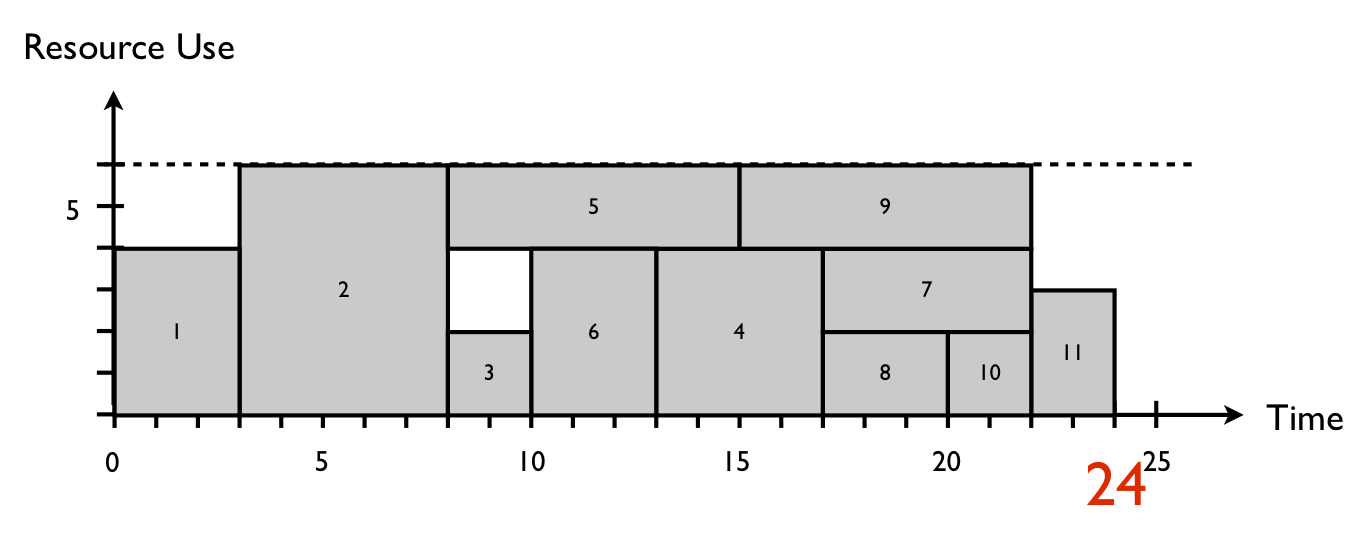What is my scheduling objective? Minimizing the resource idle time
Resource-constrained project scheduling involves the construction of an activity timetable, i.e. the determination of a start and finish time for each project activity, respecting the precedence relations and the limited availability of the renewable resources, while optimizing a predefined scheduling objective (see “Resource constrained project scheduling: What is my scheduling objective?”). In this article, the scheduling objective is assumed to be the minimization of the resource idle time of one or more bottleneck resources of the project.
Figure 1 displays a project network with 11 activities and finish-start precedence relations between them. Each number above the node denotes the estimated duration of the activity while the number below the node is used to refer to the resource demand. It is assumed that the availability of the resource is restricted to six units for all periods of the project. Moreover, it is also assumed that activities 3, 5 and 6 need an extra resource, such as a dry dock, in which the activities need to be executed (parallel execution is possible since the dry dock is large enough).

Figure 1: Project network and activity data
Work continuity
The term “work continuity constraints” is used to refer to the need for uninterrupted usage of resources used by similar activities, in order to enable the timely movement of resources (e.g. crews) from one activity to the other and to avoid idle time or loss of efficiency. These activities that make use of the same resource are grouped in so-called activity group and the objective is to minimize the time-span between the start and the finish of all activities in the group.
- Repetitive activities in the construction industry: Construction projects are often characterized by repeating activities that have to be performed from unit to unit. Examples are the construction of highway projects, pipeline constructions and high-rise buildings in which the crews perform the work in a sequence and move from one unit of the project to the next. In “Resource types: Renewable and consumable resources”, spatial resources are mentioned as a renewable resource type that are required by a group of activities, rather than by a single activity. The spatial resource is occupied from the first moment an activity from thegroup starts until the finish of all activities from that group. Examples are dry docks in a ship yard or a freezing machine in the Westerscheldetunnel (see a case study in the book "Dynamic Scheduling" (www.or-as.be/bookstore) about work continuity constraints in the Westerscheldetunnel).
- Outsourcing activities/hired material: Project scheduling problems where a set of activities has been outsourced or that rely on external resources (subcontracting, consultants, etc.) need to be scheduled with work continuity constraints. This means that the set of activities can be divided into activity groups that have to be scheduled within the smallest possible time span in order to minimize the total cost of outsourcing.
- Program scheduling with different stakeholders: In programs that consist of different projects for different stakeholders, each subproject can be seen as an individual “activity group” where work continuity can be of importance. Consequently, it is beneficial to schedule the activities within an activity group within the smallest possible time span within the precedence and resource constraints of the complete program. In doing so, the project duration towards each stakeholder is minimized and the satisfaction of the different stakeholders might be increased.
- Project with time critical sub-projects: In projects where only a subpart is time critical, work continuity constraints can be important for scheduling the time critical subnetwork.
Scheduling objective: minimize the resource idle time
In figure 2, the baseline resource-feasible schedule that minimizes the total project duration is shown, as discussed in “What is my scheduling objective? Minimizing the project lead time”. In figure 3, a similar resource-feasible schedule is displayed, as a result of the maximization of the net present value (see “What is my scheduling objective? Maximizing the net present value”).

Figure 2: A resource-feasible project schedule with the lowest possible total project duration

Figure 3: A resource-feasible project schedule with a maximum net present value
It is obvious that the baseline schedule of figure 3 is better than the schedule of figure 2 since activities 3, 5 and 6, which all belong to the same activity group, are scheduled closer to each other. The time span for the use of the dry dock is equal to 8 time periods, which is better than the 9 time periods in the schedule of figure 2. Consequently, although none of the schedules have real idle time in their use of the dry dock, work continuity constraints imply that the time span of the use of these resources is minimized, which also entails the avoidance of idle time, if possible.
© OR-AS. PM Knowledge Center is made by OR-AS bvba | Contact us at info@or-as.be | Visit us at www.or-as.be | Follow us at @ORASTalks


